Growing from seed or cutting ---------- mature characteristics
5 posters
Page 1 of 1
 Growing from seed or cutting ---------- mature characteristics
Growing from seed or cutting ---------- mature characteristics
Okay here I go again, with more questions.
Gentle reader, please note if you see me using me as an example, I am just being practical, I can't really speak for anyone else.
I am also not sure if someone has done scholarly studies on Bonsai, as it is not as important as fruit or lumber production, as luxuries go. Feel free to enlighten me, thank you.
As I have read, trees tend to take on their mature characteristics after 8 to 10 years, though I suspect there are probably some trees or shrubs that are born old looking.
I am not drawn to driftwood features or other conifers save the Japanese Black Pine and my familiarity tends to end there, save for some things that I grew up with down here, cypress from Italy, and whatever grows on the tip of Florida or came from where else - South China.
In the US, Italy and around London, Isle of Wight, I took the time to touch. So I have 5 years of experience with whatever was around those areas. I am no expert.
Anyhow, what I have observed is that for example with the Tamarind [ because it reminded me of a J.B.pine in it's second stage ] is it goes through three stages, first as relativily smooth of bark seedling, then a great deal of what I call cork bark furrows and finally the flaking bark stage.
My first tamarind did all of this and has been flaking for years, and this is going up into the branches as well.
I did shorten it in 2010, so the finer branches are starting over with stage one.
My J.B.P are from seed and the older two have what in photos are mature bark, but not lifting off as much. I saw what the Japanese could do with J.B.Pines from seed and at age 30, the tree had a goodly amount of punching out bark.
This can be seen in the Bonsai today magazines.
To take it back to tropical, the mature bark of the Gmelina cracks and can fall off on it's own and once again this goes into the shrub as it ages, around 8 to 10 years, even the mame'.
Perhaps, the others who have grown from seed or cuttings can chime in and share some observations from the cooler side [ temperature ] of the world.
By the way is it phosphorus or potassium that speeds up maturity in trees ?
Until.
No expert.
Khaimraj
Gentle reader, please note if you see me using me as an example, I am just being practical, I can't really speak for anyone else.
I am also not sure if someone has done scholarly studies on Bonsai, as it is not as important as fruit or lumber production, as luxuries go. Feel free to enlighten me, thank you.
As I have read, trees tend to take on their mature characteristics after 8 to 10 years, though I suspect there are probably some trees or shrubs that are born old looking.
I am not drawn to driftwood features or other conifers save the Japanese Black Pine and my familiarity tends to end there, save for some things that I grew up with down here, cypress from Italy, and whatever grows on the tip of Florida or came from where else - South China.
In the US, Italy and around London, Isle of Wight, I took the time to touch. So I have 5 years of experience with whatever was around those areas. I am no expert.
Anyhow, what I have observed is that for example with the Tamarind [ because it reminded me of a J.B.pine in it's second stage ] is it goes through three stages, first as relativily smooth of bark seedling, then a great deal of what I call cork bark furrows and finally the flaking bark stage.
My first tamarind did all of this and has been flaking for years, and this is going up into the branches as well.
I did shorten it in 2010, so the finer branches are starting over with stage one.
My J.B.P are from seed and the older two have what in photos are mature bark, but not lifting off as much. I saw what the Japanese could do with J.B.Pines from seed and at age 30, the tree had a goodly amount of punching out bark.
This can be seen in the Bonsai today magazines.
To take it back to tropical, the mature bark of the Gmelina cracks and can fall off on it's own and once again this goes into the shrub as it ages, around 8 to 10 years, even the mame'.
Perhaps, the others who have grown from seed or cuttings can chime in and share some observations from the cooler side [ temperature ] of the world.
By the way is it phosphorus or potassium that speeds up maturity in trees ?
Until.
No expert.
Khaimraj

Khaimraj Seepersad- Member
 Re: Growing from seed or cutting ---------- mature characteristics
Re: Growing from seed or cutting ---------- mature characteristics
Short of growing a seedling in a container for 300 years there is really no way to replicate the kind of bark that is present in a high-altitude conifer that is hundreds of years old in a container. Likewise, there is no way to replicate bark of temperate zone decidious trees, like oak, that are centuries old in a container.
Bark may take on the some mature characteristics in 8-10 years, but you haven't taken into account the environmental effects that wild-grown tree bark endures. The patina on old yamadori trees is not the simple accumulation of bark, but of years in the elements. Rain, snow, animals (and in the cases of Western U.S. and other alpine conifers--intense UV rich sunlight) and all manner of other influences that container grown trees don't experience.
Bark may take on the some mature characteristics in 8-10 years, but you haven't taken into account the environmental effects that wild-grown tree bark endures. The patina on old yamadori trees is not the simple accumulation of bark, but of years in the elements. Rain, snow, animals (and in the cases of Western U.S. and other alpine conifers--intense UV rich sunlight) and all manner of other influences that container grown trees don't experience.
rockm- Member
 Re: Growing from seed or cutting ---------- mature characteristics
Re: Growing from seed or cutting ---------- mature characteristics
Some trees & shrubs are born old, others take many decades for the bark to really mature. As example this is a privet stump that I recently acquired, bark like this cannot be faked or hurried & I doubt could ever be achieved in a pot. It has taken 50+yrs of everything rockm has touched on as well as the abuse of being a hedge along the front boundary in suburbia.
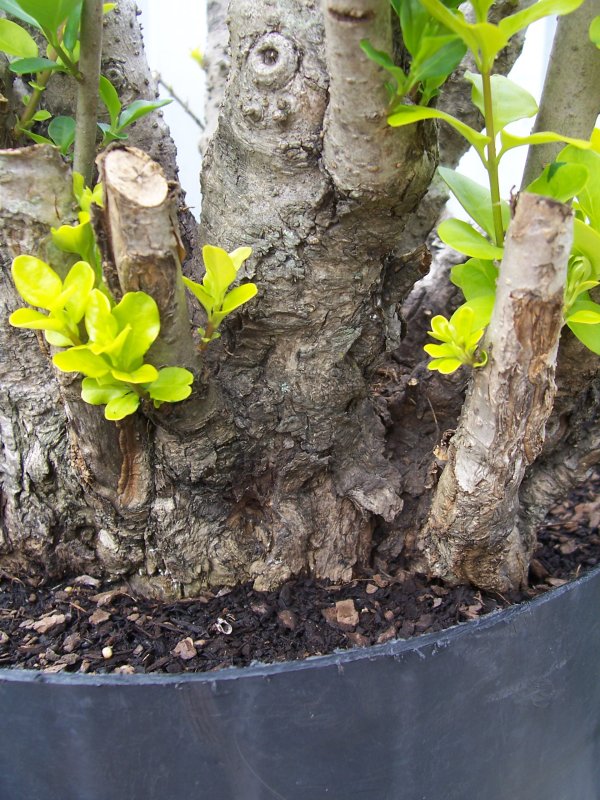
My approach is to propagate/ grow on those species that will form mature bark characteristics from a young age & collect those that wont.

My approach is to propagate/ grow on those species that will form mature bark characteristics from a young age & collect those that wont.

Guest- Guest
 Re: Growing from seed or cutting ---------- mature characteristics
Re: Growing from seed or cutting ---------- mature characteristics
Rockm,
thanks for taking the time to post.
I was rather hoping that someone in the mountains on your side who grows seeds would have responded. I have written information from the Sub-tropics and Mr.Harrington from the UK, I am looking for actual information.
Well I made sure and looked up UV, - http://www.weatheronline.co.uk/weather/maps/forecastmaps?LANG=en&CONT=namk®ION=0015&LAND=CL&LEVEL=4&R=300&CEL=C
you will find Trinidad in the South America section.
Also - https://www.niwa.co.nz/sites/default/files/import/attachments/Liley_2.pdf
It is very simple to point out problems or faults, but proof/solution and experience requires actual doing.
Has anyone tried planting a seed in the high altitudes and just observing what happens with time ?
MattA,
thanks for taking the time to post. I would also ask of you, do you know anyone on your side who has taken the time to actually grow a seed and see what happens?
Thanks for the p.m. also a member there, mostly silent.
Hey any seed folk out there in the high mountains or high mountain plateaus etc.?
Later.
Khaimraj
thanks for taking the time to post.
I was rather hoping that someone in the mountains on your side who grows seeds would have responded. I have written information from the Sub-tropics and Mr.Harrington from the UK, I am looking for actual information.
Well I made sure and looked up UV, - http://www.weatheronline.co.uk/weather/maps/forecastmaps?LANG=en&CONT=namk®ION=0015&LAND=CL&LEVEL=4&R=300&CEL=C
you will find Trinidad in the South America section.
Also - https://www.niwa.co.nz/sites/default/files/import/attachments/Liley_2.pdf
It is very simple to point out problems or faults, but proof/solution and experience requires actual doing.
Has anyone tried planting a seed in the high altitudes and just observing what happens with time ?
MattA,
thanks for taking the time to post. I would also ask of you, do you know anyone on your side who has taken the time to actually grow a seed and see what happens?
Thanks for the p.m. also a member there, mostly silent.
Hey any seed folk out there in the high mountains or high mountain plateaus etc.?
Later.
Khaimraj

Khaimraj Seepersad- Member
 Re: Growing from seed or cutting ---------- mature characteristics
Re: Growing from seed or cutting ---------- mature characteristics
Khaimraj,
I have grown many things from seed but my basic rule still applies & I now stick to those things that take on mature characteristics early in life.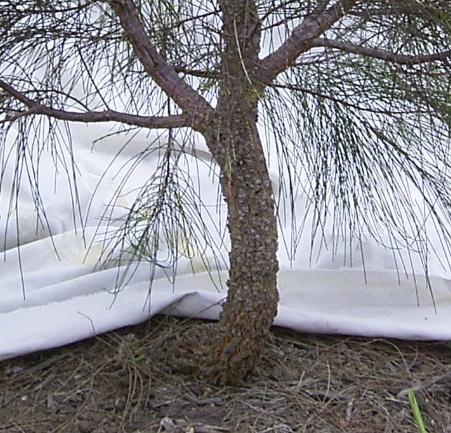
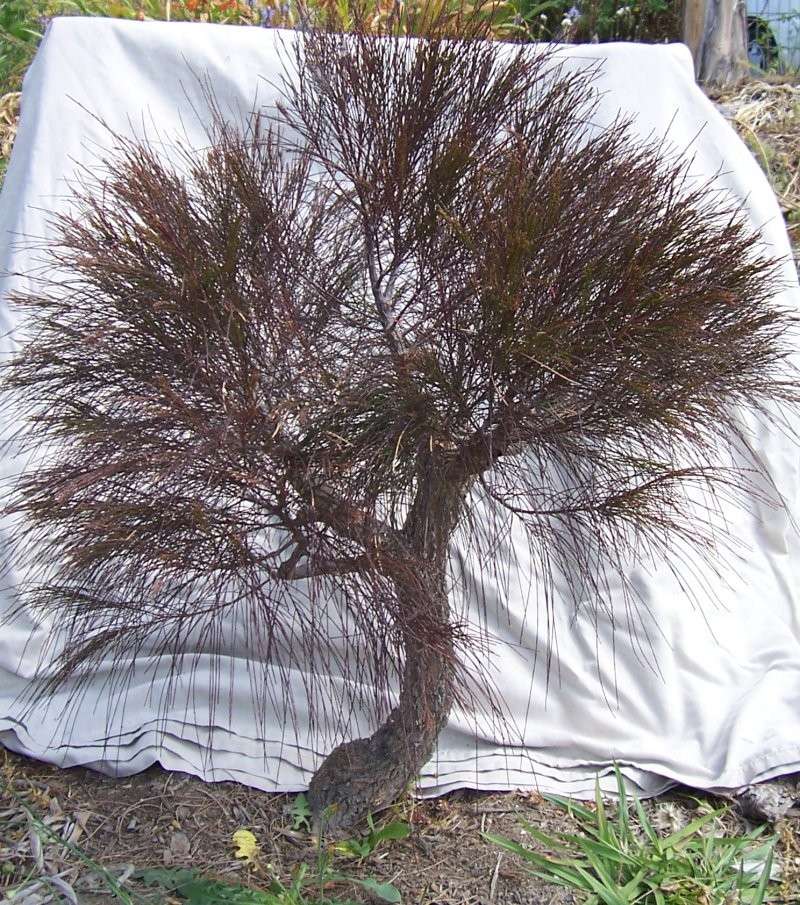 Allocasuarina are becoming one of my faves, this one is 7-8yrs from seed, the trunk barks up very early but only now are the branches also starting to develop the wonderful corky mature bark.
Allocasuarina are becoming one of my faves, this one is 7-8yrs from seed, the trunk barks up very early but only now are the branches also starting to develop the wonderful corky mature bark.
I have grown many things from seed but my basic rule still applies & I now stick to those things that take on mature characteristics early in life.

 Allocasuarina are becoming one of my faves, this one is 7-8yrs from seed, the trunk barks up very early but only now are the branches also starting to develop the wonderful corky mature bark.
Allocasuarina are becoming one of my faves, this one is 7-8yrs from seed, the trunk barks up very early but only now are the branches also starting to develop the wonderful corky mature bark.
Guest- Guest
 Re: Growing from seed or cutting ---------- mature characteristics
Re: Growing from seed or cutting ---------- mature characteristics
Hey Matt,
thanks for taking the time to show images. It is much appreciated.
I guess I would be different, I really enjoy growing seeds or cuttings, and seeing them move onto shapes and into designs. It never bugged me about the age bit and even though this island is not chock full of potentials, I am able to state that fact and just go back to growing trees.
If one is going to take the path of beauty for beauty's sake, then the objective of Bonsai becomes to create great designs.
If you chose the older way, of contemplation, any tree would work as long as the mind was allowed to dream, whilst being awake. Like scholar stones were used in Ancient China.
If you are trying for a copy of a tree in nature, then you would be thinking miniaturization.
I think I got stuck somewhere between, dreaming and a thing of beauty is a joy forever.
Later.
Khaimraj
thanks for taking the time to show images. It is much appreciated.
I guess I would be different, I really enjoy growing seeds or cuttings, and seeing them move onto shapes and into designs. It never bugged me about the age bit and even though this island is not chock full of potentials, I am able to state that fact and just go back to growing trees.
If one is going to take the path of beauty for beauty's sake, then the objective of Bonsai becomes to create great designs.
If you chose the older way, of contemplation, any tree would work as long as the mind was allowed to dream, whilst being awake. Like scholar stones were used in Ancient China.
If you are trying for a copy of a tree in nature, then you would be thinking miniaturization.
I think I got stuck somewhere between, dreaming and a thing of beauty is a joy forever.
Later.
Khaimraj

Khaimraj Seepersad- Member
 Re: Growing from seed or cutting ---------- mature characteristics
Re: Growing from seed or cutting ---------- mature characteristics
This is one of the reasons I enjoy working with Beech so much as even 3-4 year old seedlings start to get that nice grey bark. A Beech forest planting of sapling stock (particularly F. crenata) looks very mature very quickly because of this trait.
-Jay
-Jay
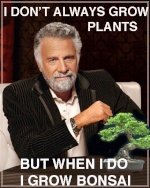
drgonzo- Member
 Re: Growing from seed or cutting ---------- mature characteristics
Re: Growing from seed or cutting ---------- mature characteristics
Jay,
any images to share ?
Thanks.
Khaimraj
any images to share ?
Thanks.
Khaimraj

Khaimraj Seepersad- Member
 Re: Growing from seed or cutting ---------- mature characteristics
Re: Growing from seed or cutting ---------- mature characteristics
"Well I made sure and looked up UV, "
You misunderstand. UV exposure increases dramatically with altitude. UV weathers organic material. The higher the tree on a mountain the more UV rays it is exposed to as there is less and less atmosphere to sheild. With ever 1000 meters in altitude, UV exposure increases 10 percent.
http://www.who.int/uv/faq/whatisuv/en/index3.html
Add to this increased exposure, air that retains less humidity and less able to support the fungi and bacteria (not to mention the sterilization effect that increased UV exposure can have) wood doesn't rot as much as it remains intact over millenia. This produces much more dramatic effects on deadwood and bark exposed in those conditions...You can't replicate in a seedling (Even at high altitude) what takes hundreds and hundreds of years to produce...
You misunderstand. UV exposure increases dramatically with altitude. UV weathers organic material. The higher the tree on a mountain the more UV rays it is exposed to as there is less and less atmosphere to sheild. With ever 1000 meters in altitude, UV exposure increases 10 percent.
http://www.who.int/uv/faq/whatisuv/en/index3.html
Add to this increased exposure, air that retains less humidity and less able to support the fungi and bacteria (not to mention the sterilization effect that increased UV exposure can have) wood doesn't rot as much as it remains intact over millenia. This produces much more dramatic effects on deadwood and bark exposed in those conditions...You can't replicate in a seedling (Even at high altitude) what takes hundreds and hundreds of years to produce...
rockm- Member
 Re: Growing from seed or cutting ---------- mature characteristics
Re: Growing from seed or cutting ---------- mature characteristics
The development of mature characteristics is very species dependent with a very strong environmental component. One can not generalize, there are too many exceptions. It may very well be true in the tropics that many species do develop mature characteristics in less than a decade, but that does not hold true at all in temperate climates. The farther north you go, the shorter the growing season, the longer it takes for trees to develop. It many be true, where you live, that rough bark develops on an Allocasurina in less than a decade. It might be true for a host of tropical species. But it is not true in zone 5.
Where you live you have roughly a 365 day growing season. Where I live, I have a 120 to 140 day growing season. Less than half the growing season you have. Lets create a hypothetical example. Say your tropical species 'A' grows at the same rate as temperate species 'B' when both species are in active growth. Similar metabolisms when in growth. One week of growth, side by side, same conditions in active growth, species A and species B would add the same amount of leaf tissue and branch extension, the same ability to photosynthesize and the same rate of sugar (energy) production. So the species are comparable. Now separate them, 'A' growing in your climate, 'B' in my climate. In one decade your species 'A' will have had more than twice the number of growing days as my temperate species 'B'. So my specimen of "B" would only look half as mature as your specimen of species 'A' at the end of that 10 year period. I think the impact of growing season is something you have not given weight to in your comments about speed to maturity. This is why you are getting so many frustrated comments from northern growers who simply have not seen, nor will they ever see, mature characteristics on their trees in the short time frames you propose.
When it comes to temperate trees, growing in temperate climates, zone 7 and colder, it is rare that mature characteristics develop in less than two decades, and for some species it may take a century or more. This is a fact, and very frustrating for those of us who enjoy raising seedlings for bonsai. This is the reason northern temperate growers are so strong in their favoring of yamadori. I enjoy the raising of trees from seed, but it is for the 'zen' experience that I enjoy it. I have a couple yamadori to give me the opportunity to attempt to create art, and enjoy that aspect of the bonsai hobby. Some of the seedlings I am growing may eventually become very nice bonsai, but most likely by the time they are nice bonsai, they will be in the hands of someone else, as I will have moved on to a different plane.
My short growing seasons is one reason that pomegranate I posted images at (in part at your encouragement ) That 40 year old seedling looks nothing like what you would expect given your climate. My tree resembles 10 year old seedlings from your area, and maybe 20 year old California trees. The number of growing days is a big factor. My tree is fully dormant 5 months of the year, and experiencing temperatures that are above freezing but too cold for rapid growth for 3 to 6 weeks on either end of my 5 month dormancy. Short growing seasons have a big effect.
) That 40 year old seedling looks nothing like what you would expect given your climate. My tree resembles 10 year old seedlings from your area, and maybe 20 year old California trees. The number of growing days is a big factor. My tree is fully dormant 5 months of the year, and experiencing temperatures that are above freezing but too cold for rapid growth for 3 to 6 weeks on either end of my 5 month dormancy. Short growing seasons have a big effect.
Where you live you have roughly a 365 day growing season. Where I live, I have a 120 to 140 day growing season. Less than half the growing season you have. Lets create a hypothetical example. Say your tropical species 'A' grows at the same rate as temperate species 'B' when both species are in active growth. Similar metabolisms when in growth. One week of growth, side by side, same conditions in active growth, species A and species B would add the same amount of leaf tissue and branch extension, the same ability to photosynthesize and the same rate of sugar (energy) production. So the species are comparable. Now separate them, 'A' growing in your climate, 'B' in my climate. In one decade your species 'A' will have had more than twice the number of growing days as my temperate species 'B'. So my specimen of "B" would only look half as mature as your specimen of species 'A' at the end of that 10 year period. I think the impact of growing season is something you have not given weight to in your comments about speed to maturity. This is why you are getting so many frustrated comments from northern growers who simply have not seen, nor will they ever see, mature characteristics on their trees in the short time frames you propose.
When it comes to temperate trees, growing in temperate climates, zone 7 and colder, it is rare that mature characteristics develop in less than two decades, and for some species it may take a century or more. This is a fact, and very frustrating for those of us who enjoy raising seedlings for bonsai. This is the reason northern temperate growers are so strong in their favoring of yamadori. I enjoy the raising of trees from seed, but it is for the 'zen' experience that I enjoy it. I have a couple yamadori to give me the opportunity to attempt to create art, and enjoy that aspect of the bonsai hobby. Some of the seedlings I am growing may eventually become very nice bonsai, but most likely by the time they are nice bonsai, they will be in the hands of someone else, as I will have moved on to a different plane.
My short growing seasons is one reason that pomegranate I posted images at (in part at your encouragement

Leo Schordje- Member
 Re: Growing from seed or cutting ---------- mature characteristics
Re: Growing from seed or cutting ---------- mature characteristics
Rockm.
I would interested in talking to someone who actually tried to grow a seedling on an exposed site at a high altitude and what they observed for say 10 to 20 years.
Any images of your own to share ?
By the way what about the part -
Latitude
UV levels are higher closer to the equator. Closer to the equator the sun's rays have a shorter distance to travel through the atmosphere and therefore less of the harmful UV radiation can be absorbed
---------------------------------------
Additionally I will check the Summer UV at mountain heights, as Winter will change the factor.
I see Denver at o and other parts of the US at 1 save for Florida.
I see us at 6.
I will look for the difference in Summer.
Much thanks for responding.
Khaimraj
I would interested in talking to someone who actually tried to grow a seedling on an exposed site at a high altitude and what they observed for say 10 to 20 years.
Any images of your own to share ?
By the way what about the part -
Latitude
UV levels are higher closer to the equator. Closer to the equator the sun's rays have a shorter distance to travel through the atmosphere and therefore less of the harmful UV radiation can be absorbed
---------------------------------------
Additionally I will check the Summer UV at mountain heights, as Winter will change the factor.
I see Denver at o and other parts of the US at 1 save for Florida.
I see us at 6.
I will look for the difference in Summer.
Much thanks for responding.
Khaimraj

Khaimraj Seepersad- Member
 Re: Growing from seed or cutting ---------- mature characteristics
Re: Growing from seed or cutting ---------- mature characteristics
Leo,
the pomegranates on our side may be an old strain from India, say 1890 or so,as are our Tamarinds.
They don't really develop any type of cracking or other type of bark feature. They also have small trunks.
My yard tree is from 1978 and still looks smooth.
I will look around for older trees.
The fruit is green with a touch or touches of red when ripe and cracking.
Later.
Khaimraj
the pomegranates on our side may be an old strain from India, say 1890 or so,as are our Tamarinds.
They don't really develop any type of cracking or other type of bark feature. They also have small trunks.
My yard tree is from 1978 and still looks smooth.
I will look around for older trees.
The fruit is green with a touch or touches of red when ripe and cracking.
Later.
Khaimraj

Khaimraj Seepersad- Member
 Re: Growing from seed or cutting ---------- mature characteristics
Re: Growing from seed or cutting ---------- mature characteristics
Hey Folks,
Rockm was kind enough to respond, but I really need to talk to someone who grows seeds at high exposed mountain altitudes, otherwise this is just going to end up as conjecture.
Is there no one doing research in the high cold latitudes ?
Are all of these comments of negativity, just folk bumping their gums, ole talk as we say ?
Help?
Khaimraj
* We have at least one guy planting pemphis seedlings on our windy, rocky and exposed north eastern coast, just to see if the phemphis will do as they do on in the East Indies.
Rockm was kind enough to respond, but I really need to talk to someone who grows seeds at high exposed mountain altitudes, otherwise this is just going to end up as conjecture.
Is there no one doing research in the high cold latitudes ?
Are all of these comments of negativity, just folk bumping their gums, ole talk as we say ?
Help?
Khaimraj
* We have at least one guy planting pemphis seedlings on our windy, rocky and exposed north eastern coast, just to see if the phemphis will do as they do on in the East Indies.

Khaimraj Seepersad- Member
 Re: Growing from seed or cutting ---------- mature characteristics
Re: Growing from seed or cutting ---------- mature characteristics
Leo,It many be true, where you live, that rough bark develops on an Allocasurina in less than a decade. It might be true for a host of tropical species. But it is not true in zone 5.
Allocasuarina torulosa is not a tropical species, nor would it survive winter in zone 5 but leaving that aside, this particular species develops rough corky bark at a very young age, even 1yr old seedling tubestock will have considerable bark, I have seen this across countless seedlings.. It is not just growing days but also species characteristics, others from the same genus do not bark up as quick, one takes decades at optimum growing conditions to produce anything other than smooth bark.
Guest- Guest
 Re: Growing from seed or cutting ---------- mature characteristics
Re: Growing from seed or cutting ---------- mature characteristics
MattA wrote:Leo,It many be true, where you live, that rough bark develops on an Allocasurina in less than a decade. It might be true for a host of tropical species. But it is not true in zone 5.
Allocasuarina torulosa is not a tropical species, nor would it survive winter in zone 5 but leaving that aside, this particular species develops rough corky bark at a very young age, even 1yr old seedling tubestock will have considerable bark, I have seen this across countless seedlings.. It is not just growing days but also species characteristics, others from the same genus do not bark up as quick, one takes decades at optimum growing conditions to produce anything other than smooth bark.
Thanks Matt, I am not familiar with Allocasuarina, so I guessed wrong about it. In my opening remarks, I made the comment about not generalizing about mature characteristics because they are species dependent, It turns out this species proves to be an example of species dependent characteristics.
Early characteristics of maturity are one reason Japanese Black Pines are popular, the cork bark cultivars show the bark trait even sooner, but then carry it on in an exaggerated way. Cork bark varieties of Chinese elms are also popular for the same reason. If you look at the most commonly used species of bonsai, most have one trait or another that lends itself to a 'mature' look. Shimpaku juniper is popular because it retains adult foliage, rarely reverting to juvenile foliage.
My point was to support those temperate climate zone growers who felt the time frame for achieving mature characteristics being proposed by the tropical climate zone grower were unrealistically short. As one of the up north guys, I am just as frustrated as the rest that it is impossible to get 1/2 inch thick bark on a ponderosa pine in less than a century. There is a reason we northern growers love our yamadori, and it is the reason we sometimes suggest to newbies growing in the north that seedlings just won't mature in a short time frame. Regardless of how many tropical and sub tropical species are pointed to as examples of quick maturing species, it is a rare species indeed that will trunk up and develop mature bark in less than 10 years IN a northern climate zone say zones 3 through 6. Many of our Canadian forum members, and some of our Alaskan members actually live so far north that they don't even have native pine trees. Or their native pines are limited to P. strobus and P. banksiana. Both of which only rarely make decent bonsai. Though I'm thinking more work needs to be done with jack pine, especially down here near its southern growing region. It might be better than the few photos and articles I've seen suggest.
so I sign off, frustrated with slow growing trees, and waiting for spring yamadori season.

Leo Schordje- Member
 Re: Growing from seed or cutting ---------- mature characteristics
Re: Growing from seed or cutting ---------- mature characteristics
"Rockm was kind enough to respond, but I really need to talk to someone who grows seeds at high exposed mountain altitudes, otherwise this is just going to end up as conjecture."
At the risk of just flapping my gums, anyone growing seedlings west of the continental divide, in Denver, most of Colorado, the intermountain West, the Pacific Northwest are doing just that, although not really all that intentionally. It's just the way U.S. geography works.
http://www.city-data.com/top13.html
At the risk of just flapping my gums, anyone growing seedlings west of the continental divide, in Denver, most of Colorado, the intermountain West, the Pacific Northwest are doing just that, although not really all that intentionally. It's just the way U.S. geography works.
http://www.city-data.com/top13.html
rockm- Member
 Re: Growing from seed or cutting ---------- mature characteristics
Re: Growing from seed or cutting ---------- mature characteristics
Yes, Rockm,
but are they specifically growing out on areas able to produce the results you keep talking about, or are they growing in sheltered zones and would they spare a few words?
Later.
Khaimraj
but are they specifically growing out on areas able to produce the results you keep talking about, or are they growing in sheltered zones and would they spare a few words?
Later.
Khaimraj
Last edited by Khaimraj Seepersad on Tue Dec 18, 2012 7:17 pm; edited 1 time in total (Reason for editing : forgot the - they)

Khaimraj Seepersad- Member
 Re: Growing from seed or cutting ---------- mature characteristics
Re: Growing from seed or cutting ---------- mature characteristics
Khaimraj,
Does nursery sapling or a "yamadori" sapling bird drop count as a "Starting from seed" in the overall life of a bonsai? Just wondering, its a question that's kind of bugging me lately when I'm trying to classify where my plants started...
That aside, regarding creating mature characteristics, I'm wondering if anyone has tried to progressively expose the roots in order to achieve mature characteristics in seedling?
I read somewhere [ 3~4 years ago and can't seem to find it back sorry ] that some Jap bloke used this method to create twisted roots mini rose bonsai.
By progressively exposing the roots.
The rose branches would be soft and green, while the exposed roots would harden off with a rough bark texture.
I've been trying this lately on some of my pre-bonsai.
This one is a ligustrum root that I am training.
Before
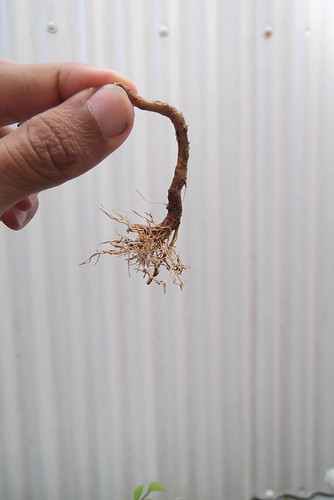

Now



In terms of time scale, the maturing process occured in less than a year. "Before" shots were in June/July 2012 and "now" shots in April 2013. The trunk's bark "seems" to be much older than 10 months.
Just exposed it to the elements [ sun, rain, wind ].
I've got another one [ exposed roots ] that's starting to mature too.
This one also is relatively new.
Its a Malpighia coccigera [ Singapore holly ]
Before
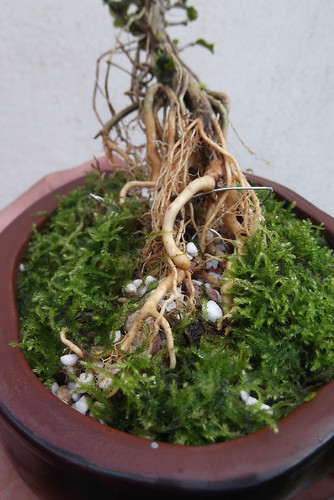
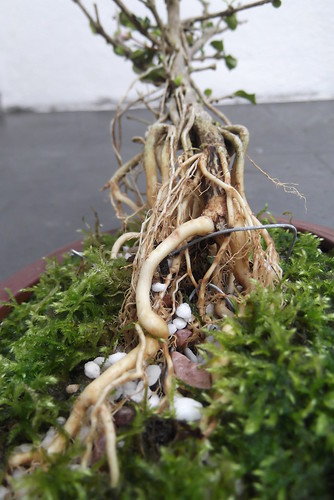
Now
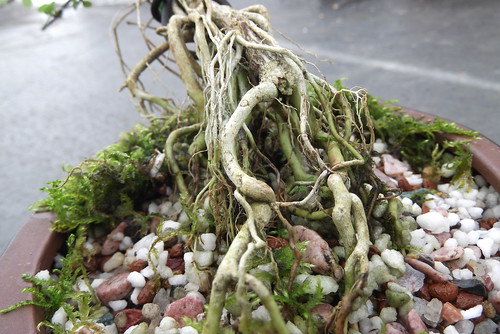

This one is a few months old in terms of maturing, but I'm expecting a mature looking bark similar to the ligustrum before december.
I have several miniature roses that I collected from my neighbour.
I'm going to try the exposed roots method on those to see how it fares.
Side note, I don't know how other trees [ decidious vs evergreen, conifers vs broadleaves etc ] would respond to having their roots gradually exposed.
I have not tried that method with any conifers for example.
Cheers
X
Does nursery sapling or a "yamadori" sapling bird drop count as a "Starting from seed" in the overall life of a bonsai? Just wondering, its a question that's kind of bugging me lately when I'm trying to classify where my plants started...
That aside, regarding creating mature characteristics, I'm wondering if anyone has tried to progressively expose the roots in order to achieve mature characteristics in seedling?
I read somewhere [ 3~4 years ago and can't seem to find it back sorry ] that some Jap bloke used this method to create twisted roots mini rose bonsai.
By progressively exposing the roots.
The rose branches would be soft and green, while the exposed roots would harden off with a rough bark texture.
I've been trying this lately on some of my pre-bonsai.
This one is a ligustrum root that I am training.
Before


Now



In terms of time scale, the maturing process occured in less than a year. "Before" shots were in June/July 2012 and "now" shots in April 2013. The trunk's bark "seems" to be much older than 10 months.
Just exposed it to the elements [ sun, rain, wind ].
I've got another one [ exposed roots ] that's starting to mature too.
This one also is relatively new.
Its a Malpighia coccigera [ Singapore holly ]
Before


Now


This one is a few months old in terms of maturing, but I'm expecting a mature looking bark similar to the ligustrum before december.
I have several miniature roses that I collected from my neighbour.
I'm going to try the exposed roots method on those to see how it fares.
Side note, I don't know how other trees [ decidious vs evergreen, conifers vs broadleaves etc ] would respond to having their roots gradually exposed.
I have not tried that method with any conifers for example.
Cheers
X

Xavier de Lapeyre- Member
 Re: Growing from seed or cutting ---------- mature characteristics
Re: Growing from seed or cutting ---------- mature characteristics
Xavier,
good to see you doing!!
With pines, what was shown in Bonsai Today, was planting the seed in very coarse soil and letting the roots wonder here and there. Speeds up growth and gives you roots with tons of personality.
AND you know you can grow Japanese Black Pines on your side as well as the Caribbean/Honduran pine [ possibly used in your pine plantations if you have them.]
Let me know how long the ligustrum lives, mine from China only lived 5 or 6 years but grew very aggressively and then would slow down in the last year, to eventually die.
Malpighia c. is as Bougainvillea to me. No can grow. Drops over dead, when I look at them. More power to you!!
Be happy for me, I actually go a Casuarina to grow, after years of kaput. Trouble is the equisetifolia is supposed to only live for about 20 years. So with my luck, I will get a beautiful specimen, display it once and get up next day to a corpse.
Perhaps you might wish to try the Japanese technique with the very coarse soil? I will look it up again tonight and get back to you.
You know you can do the same with Chinese elms, Fukien tea and Serissa s., grown from roots and tons of character ?
Serissa s. can actually do the mangrove style with all the arching roots. We have a guy down here accidentally doing it [ I hope it is still alive.]
Thanks for responding and with images.
Stay Well.
Khaimraj
* Hee hee, I actually have a few Yamadori bird dropping seed to be bonsai efforts -

good to see you doing!!
With pines, what was shown in Bonsai Today, was planting the seed in very coarse soil and letting the roots wonder here and there. Speeds up growth and gives you roots with tons of personality.
AND you know you can grow Japanese Black Pines on your side as well as the Caribbean/Honduran pine [ possibly used in your pine plantations if you have them.]
Let me know how long the ligustrum lives, mine from China only lived 5 or 6 years but grew very aggressively and then would slow down in the last year, to eventually die.
Malpighia c. is as Bougainvillea to me. No can grow. Drops over dead, when I look at them. More power to you!!
Be happy for me, I actually go a Casuarina to grow, after years of kaput. Trouble is the equisetifolia is supposed to only live for about 20 years. So with my luck, I will get a beautiful specimen, display it once and get up next day to a corpse.
Perhaps you might wish to try the Japanese technique with the very coarse soil? I will look it up again tonight and get back to you.
You know you can do the same with Chinese elms, Fukien tea and Serissa s., grown from roots and tons of character ?
Serissa s. can actually do the mangrove style with all the arching roots. We have a guy down here accidentally doing it [ I hope it is still alive.]
Thanks for responding and with images.
Stay Well.
Khaimraj
* Hee hee, I actually have a few Yamadori bird dropping seed to be bonsai efforts -

Khaimraj Seepersad- Member
 Similar topics
Similar topics» Growing from seed /cutting - images - 17 years
» New to Bonsai, new to this group - Growing from a cutting
» Developing bonsai from seed or cutting.
» Growing Pyracantha from seed
» The secret of seed growing
» New to Bonsai, new to this group - Growing from a cutting
» Developing bonsai from seed or cutting.
» Growing Pyracantha from seed
» The secret of seed growing
Page 1 of 1
Permissions in this forum:
You cannot reply to topics in this forum






